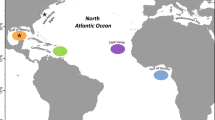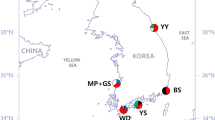Abstract
The Pacific bluefin tuna Thunnus orientalis is a highly migratory species, some tuna exhibiting a trans-Pacific migration between the Western Pacific Ocean (WPO) to the Eastern Pacific Ocean (EPO) at the juvenile stage. To detect a signature for the eastward trans-Pacific migration, we analyzed otolith stable isotope ratios of carbon (δ13Coto) and oxygen (δ18Ooto) along the growth trajectory for 20 migrants (age 3–5 years) from the EPO and 10 residents (age 2–3 years) from the WPO. The δ18Ooto values for migrants recorded during the eastward trans-Pacific migration were higher than those for residents during the same period. The higher δ18Ooto values for migrants reflect the low water temperatures encountered during their migration. The δ13Coto values were higher in the migrants than in the residents, suggesting that the higher values of carbon isotope ratios of both dissolved inorganic carbon and the diet in the EPO are recorded in the δ13Coto profiles. Our study demonstrates that otolith isotope analyses can successfully detect trans-Pacific migration of the Pacific bluefin tuna.




Similar content being viewed by others
References
Ashida H, Suzuki N, Tanabe T, Suzuki N, Aonuma Y (2015) Reproductive condition, batch fecundity, and spawning fraction of large Pacific bluefin tuna Thunnus orientalis landed at Ishigaki Island, Okinawa, Japan. Environ Biol Fish 98:1173–1183
Bayliff WH, Ishizuka Y, Deriso RB (1991) Growth, movement, and attrition of northern bluefin tuna, Thunnus thynnus, in the Pacific Ocean, as determined by tagging. IATTC Bull 20:3–94
Bayliff WH (1993) Growth and age composition of northern bluefin tuna, Thunnus thynnus, caught in the Eastern Pacific Ocean, as estimated from length–frequency data, with comments on trans-Pacific migrations. Inter Am Trop Tuna Comm Bull 20:501–540
Bigg GR, Rohling EJ (2000) An oxygen isotope data set for marine waters. J Geophys Res 105:8527–8535
Boustany AM, Matterson R, Castleton M, Farwell C, Block BA (2010) Movements of Pacific bluefin tuna (Thunnus orientalis) in the Eastern North Pacific revealed with archival tags. Prog Oceanogr 86:94–104
Buentello A (2016) Tuna farming in Japan and Mexico. In: Benetti DD, Partridge GJ, Buentello A (eds) Advances in Tuna Aquaculture: from hatchery to market. Elsevier, Massachusetts, pp 203–204
Campana SE (1999) Chemistry and composition of fish otoliths: pathways, mechanisms and applications. Mar Ecol Prog Ser 188:263–297
Chen KS, Crone P, Hsu CC (2006) Reproductive biology of female Pacific bluefin tuna Thunnus orientalis from south-western North Pacific Ocean. Fish Sci 72:985–994
Chung MT, Trueman CN, Godiksen JA, Grønkjær P (2019a) Otolith δ13C values as a metabolic proxy: approaches and mechanical underpinnings. Mar Freshw Res 70:1747–1756
Chung MT, Trueman CN, Godiksen AJ, Holmstrup ME, Grønkjær P (2019b) Field metabolic rates of teleost fishes are recorded in otolith carbonate. Commun Biol 2:24. https://doi.org/10.1038/s42003-018-0266-5
Craig H (1957) Isotopic standards for carbon and oxygen and correction factors for mass-spectrometric analysis of carbon dioxide. Geochim Cosmochim Acta 12:133–149
Darnaude AM, Hunter E (2018) Validation of otolith δ18O values as effective natural tags for shelf-scale geolocation of migrating fish. Mar Ecol Prog Ser 598:167–185
Fujioka K, Fukuda H, Furukawa S, Tei Y, Okamoto S, Ohshimo S (2018a) Habitat use and movement patterns of small (age-0) juvenile Pacific bluefin tuna (Thunnus orientalis) relative to the Kuroshio. Fish Oceanogr 27:185–198. https://doi.org/10.1111/fog.12244
Fujioka K, Fukuda H, Tei Y, Okamoto S, Kiyofuji H, Furukawa S, Takagi J, Estess E, Farwell CJ, Fuller DW, Suzuki N, Ohshimo S, Kitagawa T (2018b) Spatial and temporal variability in the trans-Pacific migration of Pacific bluefin tuna (Thunnus orientalis) revealed by archival tags. Prog Oceanogr 162:52–65
Furukawa S, Fujioka K, Fukuda H, Suzuki N, Tei Y, Ohshimo S (2016) Archival tagging reveals swimming depth and ambient and peritoneal cavity temperature in age-0 Pacific bluefin tuna, Thunnus orientalis, off the southern coast of Japan. Environ Biol Fish 100:35–48
Gruber N, Keeling CD, Bacastow RB, Guenther PR, Lueker TJ, Wahlen M, Meijer HAJ, Mook WG, Stocker TF (1999) Spatiotemporal patterns of carbon-13 in the global surface oceans and the oceanic Suess effect. Glob Biogeochem Cycles 13:307–335
Høie H, Folkvord A, Otterlei E (2003) Effect of somatic and otolith growth rate on stable isotopic composition of early juvenile cod (Gadus morhua L.) otoliths. J Exp Mar Biol Ecol 289:41–58
IATTC, Fishery Status Report No. 16 (Inter-American Tropical Tuna Commission, La Jolla, CA, 2018)
ISC (2018) Pacific Bluefin Tuna stock assessment. International Scientific Committee for Tuna and Tuna-like Species in the North Pacific Ocean, Yeosu, Republic of Korea
Kitagawa T, Kimura S, Nakata H, Yamada H, Nitta A, Sasai Y, Sasaki H (2009) Immature Pacific bluefin tuna, Thunnus orientalis, utilizes cold waters in the subarctic frontal zone for trans-Pacific migration. Environ Biol Fish 84:193–196
Kitagawa T, Ishimura T, Uozato R, Shirai K, Amano Y, Shinoda A, Otake T, Tsunogai U, Kimura S (2013) Otolith δ18O of Pacific bluefin tuna Thunnus orientalis as an indicator of ambient water temperature. Mar Ecol Prog Ser 481:199–209
Kroopnick PM (1985) The distribution of 13C of ΣCO2 in the world oceans. Deep-Sea Res 32:57–84
Kubo T, Sakamoto W, Murata O, Kumai H (2008) Whole-body heat transfer coefficient and body temperature change of juvenile Pacific bluefin tuna Thunnus orientalis according to growth. Fish Res 74:995–1004
Magozzi S, Yool A, Vander Zanden HB, Wunder MB, Trueman CN (2017) Using ocean models to predict spatial and temporal variation in marine carbon isotopes. Ecosphere 8:e01763
Madigan DJ, Litvin SY, Popp BN, Carlisle AB, Farwell CJ, Block BA (2012) Tissue turnover rates and isotopic trophic discrimination factors in the endothermic teleost, Pacific bluefin tuna (Thunnus orientalis). PLoS ONE 7:e49220. https://doi.org/10.1371/journal.pone.0049220
Madigan DJ, Baumann Z, Carlisle AB, Hoen DK, Popp BN, Dewar H, Snodgrass OE, Block BA, Fisher NS (2014) Reconstructing transoceanic migration patterns of Pacific bluefin tuna using a chemical tracer toolbox. Ecology 95:1674–1683
Madigan DJ, Boustany A, Collette BB (2017) East not least for Pacific bluefin tuna. Science 357:356–357
Ohshimo S, Sato T, Okochi Y, Tanaka S, Ishihara T, Ashida H, Suzuki N (2018) Evidence of spawning among Pacific bluefin tuna, Thunnus orientalis, in the Kuroshio and Kuroshio-Oyashio transition area. Aquat Living Resour 31:33. https://doi.org/10.1051/alr/2018022
Okochi Y, Abe O, Tanaka S, Ishihara Y, Shimizu A (2016) Reproductive biology of female Pacific bluefin tuna, Thunnus orientalis, in the Sea of Japan. Fish Res 174:30–39
Patterson W, Smith G, Lohmann K (1993) Continental paleothermometry and seasonality using the isotopic composition of aragonite otoliths of freshwater fishes. Geophys Monogr 27:199–202
R Core Team (2019) R: a language and environment for statistical computing. R Foundation for Statistical Computing, Vienna
Radtke RL, Williams DF, Hurley PCF (1987) The stable isotopic composition of bluefin tuna (Thunnus thynnus) otoliths: evidence for physiological regulation. Comp Biochem Physiol A 87:797–801
Shiao JC, Wang SW, Yokawa K, Ichinokawa M, Takeuchi Y, Chen YG, Shen CC (2010) Natal origin of Pacific bluefin tuna Thunnus orientalis inferred from otolith oxygen isotope composition. Mar Ecol Prog Ser 420:207–219
Shimose T, Ishihara T (2015) A manual for age determination of Pacific bluefin tuna Thunnus orientalis. Bull Fish Res Agen 40:1–11
Shimose T, Wells RD (2015) Feeding ecology of bluefin tunas. In: Kitagawa T, Kimura S (eds) Biology and ecology of bluefin tuna. CRC Press, Boca Raton, pp 78–97
Solomon CT, Weber PK, Cech JJ, Ingram BL, Conrad ME, Machavaram MV, Pogodina AR, Franklin RL (2006) Experimental determination of the sources of otolith carbon and associated isotopic fractionation. Can J Fish Aquat Sci 63:79–89
Sylvia P, Belle S, Smart A (2003) Current status and future prospective of bluefin tuna (Thunnus thynnus orientalis) farming in Mexico and the West Coast of the United States. In Bridges CR, García A, Gordin H. (eds.). Domestication of the bluefin tuna Thunnus thynnus. Zaragoza: CIHEAM. pp 197–00 (Cahiers Options García A, Gordin H. (eds.). Domestication of the bluefin tuna Thunnus thynnus. Zaragoza: CIHEAM. pp 197–00 (Cahiers Options
Tawa A, Ishihara T, Uematsu Y, Ono T, Ohshimo S (2017) Evidence of westward transoceanic migration of Pacific bluefin tuna in the Sea of Japan based on stable isotope analysis. Mar Biol 164:94. https://doi.org/10.1007/s00227-017-3127-8
Thorrold SR, Campana SE, Jones CM, Swart PK (1997) Factors determining δ13C and δ18O fractionation in aragonitic otoliths of marine fish. Geochim Cosmochim Acta 61:2909–2919
Tohse H, Mugiya Y (2008) Sources of otolith carbonate: experimental determination of carbon incorporation rates from water and metabolic CO2, and their diel variations. Aquat Biol 1:259–268
Acknowledgements
We thank Y. Tanaka, H. Tanaka, Y. Hiraoka, H. Ashida, S. Ohshimo, K. Sato, T. Sato, E. Sawai, Y. Mochizuki, K. Nagasawa, K. Koizumi and S. Konagaya of the National Research Institute of Far Seas Fisheries for valuable advice and support, and the staff of the Japan Agency for Marine-Earth Science and Technology for the stable isotope analysis. We are also grateful to the staff of Japan NUS Co., Ltd. for assistance.
Funding
This study was funded by a grant from the Fisheries Agency of Japan.
Author information
Authors and Affiliations
Corresponding author
Ethics declarations
Conflict of interest
The authors declare that they have no conflict of interest.
Ethical approval
All Pacific bluefin tuna specimens were caught and handled by commercial fisheries (long line and purse seine fishing) in Japan and in Mexico, and they were not killed for this study. The catch of this species is controlled by the Japanese Government based on the assessment of the Western and Central Pacific Fisheries Commission (WCPFC) in Japanese waters and by the Mexican Government based on the assessment of the Inter-American Tropical Tuna Commission (IATTC 2014–2017) in American-Mexican waters.
Additional information
Reponsible Editor: E. Hunter.
Reviewed by J. Mohan and T. Sakamoto.
Publisher's Note
Springer Nature remains neutral with regard to jurisdictional claims in published maps and institutional affiliations.
Electronic supplementary material
Below is the link to the electronic supplementary material.




Rights and permissions
About this article
Cite this article
Kawazu, M., Tawa, A., Ishihara, T. et al. Discrimination of eastward trans-Pacific migration of the Pacific bluefin tuna Thunnus orientalis through otolith δ13C and δ18O analyses. Mar Biol 167, 110 (2020). https://doi.org/10.1007/s00227-020-03723-9
Received:
Accepted:
Published:
DOI: https://doi.org/10.1007/s00227-020-03723-9




